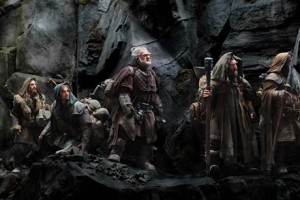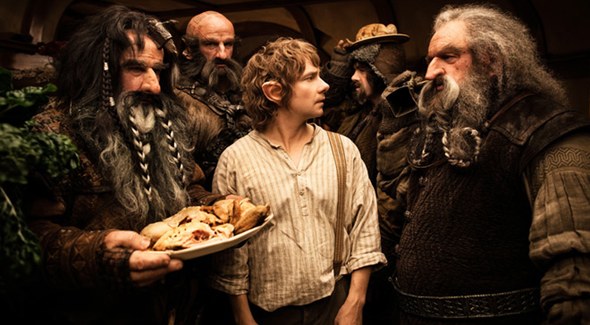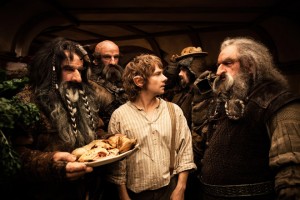Watching The Hobbit: An Unexpected Journey from the front of an IMAX theater felt familiar—the comfortable art and production style of the Lord of the Rings films are writ large—but it left me with two very powerful emotions that I think drive to the heart of what this movie is trying to accomplish, both on its own and part of the Middle-Earth imaginations of Peter Jackson’s posse: I felt very high, and I felt very hungry.
Hungry, of course, because of the cheese wheels as tall as a man on the IMAX screen, or jars of scones that would make reasonable above-ground swimming pools. The Lord of the Rings movies make joke and reference to the hearty Warwickshire fare of The Shire—and the penchant of halflings for multiple dinners and breakfasts. But in The Hobbit, the characters eat. And eat and eat and eat.
And high of course not because of Gandalf’s pipe weed or Radagast’s magic mushrooms, but because of the dozens of great heights or falls—flying shots of vast chasms, roaming tours of bottomless underground vaults, and Eagle Ex Machina flyovers of the vast expanses of air under truly giantic cliffs.
Seriously, this movie gets high. Characters stand on the edges of precepices in at least ten different scenes. The throngs of enemy henchmen hurtling to their deaths over railings and catwalks rival the American Ninja series. Bad guys fall a lot, and good guys “almost fall” a lot more.
Both of these factors are present in The Lord of the Rings films, but not in anywhere near the degree to which they dominate and inform The Hobbit.
There and Back Again
This is all about the heart of The Hobbit—not the ring, not the dragon, not even Bilbo’s own experience on the open road—the heart is at Bag End in Bilbo’s house. Plenty of movies introduce a safe home and contrast it with a dangerous world on the outside—but The Hobbit does it very directly, creating a sense of the journey from Bilbo’s perspective by not just showing us something different from Bilbo’s home, but by showing us the exact opposite.
Bilbo lives in a comfortably shallow Hobbit hole and is short and close to the ground. Height is about as foreign to him as a concept can get.
And Bilbo is not shown in The Hobbit to be a ravenous eater. Instead, in a lovely scene, we watch him delicately and patiently prepare a fish for his dinner, which we are to understand he will eat slowly and savor. Biblo is not fat, and one wonders why his pantry is sufficiently stocked for a dinner for 14 when he lives alone and appears to not eat so extraordinarily much at all.
No, Bilbo’s packed larder does not show his love of eating; it shows that he is never hungry.
The direct contrasts here are found throughout the film: the dwarves feast and sing and eat cheese by the wheel; the trolls have a sympathetic human fondness for seasoning their pseudo-cannibalistic stews and kabobs—and get caught in argument and misdirection over it until they go unfed and turn to stone; Gollum relishes the goblin he beats to death and eats in front of Bilbo with a horrifying sensuality‚ and even the Smeagol side of Gollum seems excited at the prospect of eating Bilbo should he lose the riddle contest.
And, of course, the party is hounded by wolfish wargs and warg-riders who have given up the power of speech they exhibit in the book for pure animal hunger—they chomp through trees as readily as through flesh. Radagast leads them away with his rabbit sledge, and we all know why dogs chase rabbits.
 (Fish and rabbits are important symbolic foods across the Lord of the Rings franchise as well: they are the two foods that Sam and Frodo share with Gollum in Mordor. If we see sparing Gollum’s life as the central dramatic act of the whole body of work, this is very important.)
(Fish and rabbits are important symbolic foods across the Lord of the Rings franchise as well: they are the two foods that Sam and Frodo share with Gollum in Mordor. If we see sparing Gollum’s life as the central dramatic act of the whole body of work, this is very important.)
At any rate, Biblo goes from a place where he is never hungry to a place where everyone is always hungry, just as he goes from a place where he is never far from the ground to a place where everyone is always dangling far above it by their fingertips.
Translating the medium
I want to be clear that I am talking about the movie here. While the project seems enough of a collage of disparate priorities to resist attribution to a single auteur, this is an interpretation in the film medium of senses and sensations that are present in the book and work in slightly different ways.
Certainly there is lots of food and song in the book The Hobbit, and certainly there are treacherous mountain passes, but the advantage in prioritizing these elements in a movie is they provoke a visceral reaction from an audience because of our involuntary reactions to seeing these things.
That is, when we see a lot of tasty food, we don’t have a ton of control over whether or not it makes us hungry. And if we look over a ledge or railing to a steep drop, we don’t have a ton of control over whether it alarms us or gives us vertigo. As we see the thing, the reaction is already decided.
What is does in the movie is force Biblo’s perspective—force the arc of his journey—onto the audience; it tries to prompt us not to understand it, but to experience it, and not to experience it in terms of what we might generally care about in epic fantasy movies—the courage, action, romance, magic, violence, honor, glory, etc.—but to experience it in terms of what Bilbo would find most important—the feeling of hunger and physical disorientation.

Perhaps the most understated moment in the movie is the morning after his unexpected party, where Bilbo decides he will drop his resistance and chase after Thorin Oakenshield’s party, on to his adventure. It is never explained to my satisfaction why this happens, but there is a powerful, knowing shot of Bilbo’s empty and depleted dining area as Bilbo makes his decision.
The way I see it, all the food has been eaten, which introduces a new element to Bilbo’s life: wanting something he doesn’t have. Bilbo connects the absence of his food in his house to the absence of his new friends and their quest, finding a hunger for companionship adventure in his heart that had been dulled by decades of plenty.
It’s a great example of saying something with images rather than words, and a good example of what being a movie can add to the story of The Hobbit such that, as it continues, it is hopefully not just a series of “almost-as-goods” lost to the inadequacies of cross-media translation, but an addition to the overall work, a contribution from what film can say and text really cannot.


Is it really any wonder that the literary reputation of Tolkien stagnated until stoned hippies discovered his work?
I think you’re on to something — but of course it’s not just that the Valar and the Maiar and the Rings of Power and all the dudes with crazy names are attractive to people fond of psychedelia.
I’d imagine if your life were fraut with physical hardships — if you were always cold or hungry, or you had to work in a factory or a mine 10 hours a day — or if you had never known a great deal of personal safety, Bilbo Baggins might not be a particularly attractive character to you. The idea that you still have a whole lot to gain after you’re safe and comfortable and well-fed is kind of offensive from certain perspectives.
But if you had a group of people who were generally well-off and doing okay, but still felt really uncomfortable with the state of the world in a way that they felt called on them to step outside their personal comfort, those people would probably identify with Bilbo more.
His comfort grants them not just a parable for their political adventurism, but also a moral superiority from their previous disinvolvement.
I just don’t get how both the hippies and Jackson seem to think “pipe weed” isn’t tobacco when it is obvious that’s what Tolkien meant. Yeah, yeah “weed”. But that’s as juvenile as sniggering at old books that use “ejaculate” as a verbal verb.
Which is hilarious.
It’s kind of understandable, given how the economies of the two crops have changed.
Tolkien’s “pipe weed” is a locally-grown crop, cultivated for quality by a specific people and enjoyed at times of leisure and relaxation.
Now, this might have been how Tolkien saw a sort of “classic fantasy tobacco” — he was an Oxonian and an early-mid 20th century smoker of pipes.
But through the mid-to-late 20th century and into the 21st the culture of tobacco became very different from this — if it ever really did resemble it. Tobacco is mass-produced by giant global corporations and aggressively marketed for maximum consumption — the overwhelming majority of tobacco is smoked in cigarettes by the pack at constant intervals, as a result of addiction — often frenetically — not as a leisure activity. “Quality” tobacco or “craft” tobacco, while not especially rare, is such a small fraction of the tobacco produced and consumed that it isn’t really identifiable as such. Rolling papers are less likely to be used for hand-rolled cigarettes than for pot.
Now to contrast, of course marijuana is grown in great quantity by cartel suppliers and other institutional growers — but there is still the presence and at least mythological primacy of locally grown marijuana, with a greater focus on quality of experience and less of a focus on maximum production and consumption. And it’s still a leisure activity, not something that is seen as biologically mandatory by unfortunate chance and kind of hostile to comfortable living.
So, while the plant is clearly tobacco, the economic and cultural role of it much more closely resembles marijuana, precisely because we don’t have large-scale legal growing of marijuana by U.S. agribusiness corporations.
This is the sort of discussion I find fascinating. There are a lot of non-(pop culture) ideas that ought to be subjected to a level of scrutiny they probably don’t deserve.
I had a different take on the “morning after” the unexpected party. It wasn’t the complete absence of food that was striking — it was the spotless orderliness. After that party, weren’t you expecting to see a fratworthy mess?
This was a crucial point, one well known to those who have ever evaluated group-living establishments. And if Bilbo had had to clean up a mess, poor odds that he’d ever have caught up with the dwarves.